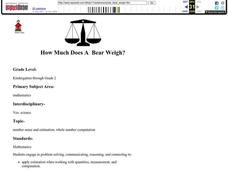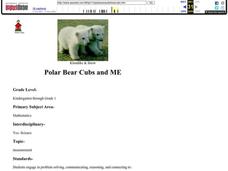Curated OER
IDENTIFYING AND SORTING BEARS
Students study the difference between living and nonliving bears by classifying pictures of bears and placing them on the appropriate posterboard. Given pictures of bears, students recognize types of bears by placing the pictures correctly.
Curated OER
OUR FAVORITE BEARS
Students state bear facts aloud, practice counting the nuber of bears aloud on the picture graph, read the picture graph and answer questions aloud about the data on the picture graph, and draw a picture of their favorite bear.
Curated OER
Bears, Bears, and More Bears!
Students learn the different kinds of bears, discover how bears move, andlearn what bears eat. They also explore bear habitats and list the differences between real bears and imaginary or fantasy bears
Curated OER
Travel to the Polar Lands
Second graders receive an "Expedition Ticket" to travel through the Polar Regions- the Arctic and the Antarctic. They research polar bears and make drawings that are to scale.
Curated OER
Observation And Listening Skills
First graders read a story about polar bears and make observations as they read. In this observations lesson plan, 1st graders listen carefully and sing a bear chant.
Curated OER
Help Save the Polar Bear
Pupils use ice cubes to demonstrate how the polar ice caps are melting and how it effects the polar bears. In this polar bear lesson plan, the teacher explains how polar bears live on the north pole and how they are having trouble due to...
Curated OER
Bears Dot to Dot
In this connect the dots activity, students connect the dots and draw a line using the numbers 1-16 to outline the picture of a bear.
Curated OER
Trace the Bear
In this tracing worksheet, students trace a picture of a bear by following the dotted lines. They trace the dotted lines to form the word bear.
Curated OER
B for Bear
In this bear worksheet, students read informational passages that detail facts about bears. Students also read a short poem about a bear.
Curated OER
Help Save the Polar Bear
In this energy conservation instructional activity, students read the poem about saving energy by changing light bulbs to save polar bears. Students may color the bear.
Curated OER
Bear on the Run Maze
In this hand-eye coordination and problem solving worksheet, students help a bear find his way through the woods to jump into a stream by tracing a path on the maze.
Curated OER
Fuzzy Bear Connect the Dots
In this math worksheet, students practice counting to 50 by completing a dot to dot picture of a big bear who is dreaming of honey. Students color the picture.
Curated OER
Bears Word Search Puzzle
In this bear vocabulary word search puzzle worksheet, students will find and circle 44 bear related words. Words include Grizzly and Yogi.
Curated OER
Larger and Smaller Numbers 3
For this mathematics worksheet, students color the box in each set with the smaller number first. Then they color the box in each set with the larger number at the bottom of the page.
Curated OER
Special Message Word Puzzle-- Panda Bears
For this language arts worksheet, students read 30 clues and fit the answers in a word puzzle grid. All answers have 4 letters but there is no word bank.
Curated OER
6 6 6 - 6 BEARS
In this printing worksheet, students are given a line drawing of 6 bears. They are also given lines on which to copy the number "6."
Curated OER
Animals of the Cold
Students access the Internet to research information about animals found in the coldest parts of the world. They gather data for collaborative exchange and research answers to teacher designed questions. They create original works of art...
Curated OER
Learning About Bears And Dolphins
Seventh graders engage in a study that compares the body structures of bears and dolphins. They conduct research to find information and use questions to find the differences or similarities and then conduct a class discussion about the...
Curated OER
Learning About Bears
Learners receive instruction about the different types of bears: Brown bears, Polar bears, and Panda bears. They then work on a worksheet independently to show how well they comprehended the instruction.
Curated OER
The Bear Necessities: A K-2 Computer Activity
Students demonstrate understanding of basic facts of polar bears based on their completed worksheets. They then demonstrate basic skill at scrolling on a Web page and identify key points in text.
Curated OER
How Much Does a Bear Weigh?
Students estimate how many children in their class it would take to equal the mass of one adult bear. They then weigh and record their measurement on a chart to check their estimate.
Curated OER
Polar Bear Cubs and ME
Students visit the following web site to find out the birth weights and lengths of polar bear cubs- Ask Jeeves for Kids. They then enter the information found at this site relating to the birth length and weight of polar bear cubs into a...
Curated OER
Hibernating Hoopla
Students simulate hibernation with their stuffed animals. They predict the length of time of hibernation and type their math journal entries about sorting, graphing and draw pictures. They read bear hibernation stories.
Curated OER
Bears
Students complete a variety of bear-related activities. They sort and graph teddy bears, distinguish between real and non-real bears and research bear life cycles and habitats.

























